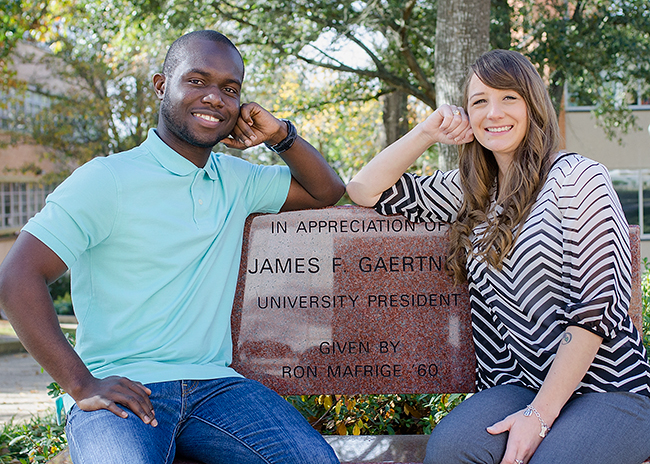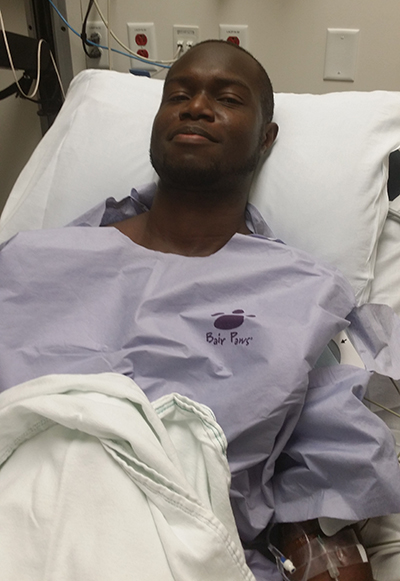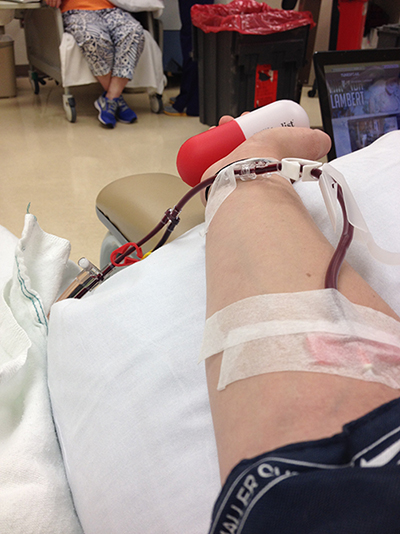Students 'Donate' A Second Chance Through Marrow Registry Program
Dec. 16, 2014
SHSU Media Contact: Romney Thomas
 |
| Oluwapelumi Ade-Kolawole and Julie Dziema come from very different backgrounds, but they share a desire to help others. Both signed up for SHSU's Be The Match on-campus registry and only months later were informed that their marrow was needed to save a life. —Photo by Brian Blalock |
When graduating senior in health sciences Julie Dziema and Master of Arts in health candidate Oluwapelumi Ade-Kolawole signed up for one of Sam Houston State University’s Be The Match registries on campus, both knew the chances of being selected were quite small.
Only approximately five to eight students become a match each year, according to Health and Kinesiology faculty member Courtney Wallace, who works closely with Be The Match to recruit students for its bone marrow registry.
“We have many students who are potential matches, but once they undergo more testing, they are not always the best match,” she said.
Because registry representatives tell students that the likelihood of actually being a patient’s match is small, it was quite a surprise to Dziema, Ade-Kolawole and those involved with on-campus registry to learn that SHSU was home to two students who were able to complete the life-saving process of bone marrow donation this past semester.
For Dziema and Ade-Kolawole, the news of being a patient’s potential match came only a matter of months after joining the registry.
“I was very excited and shocked that it happened so quickly,” Dziema said. “I couldn’t wait to get the donation process started.”
Ade-Kolawole said that the likelihood that he would be selected was considered to be even slimmer.
“I’m from Nigeria,” said Ade-Kolawole. “I never thought that I would be someone’s match. I just thought I would volunteer to be on the registry, but for whatever reason, I was discovered to be someone’s match.”
 |
| Ade-Kolawole (above) and Dziema also had different experiences in the donation of their bone marrow. Ade-Kolawole had the more traditional procedure, which requires patients to undergo anesthesia; Dziema underwent a process that required a series of inections leading up to the procedure and then donated through the blood that was drawn, a nine-hour process, seen below. |
 |
After being notified that they were each being considered for marrow donation, Dziema and Ade-Kolawole underwent extensive blood testing in order to be compared to a pool of other potential matches.
In this way, the process for donation was very similar for both donors. Once they were confirmed as the best possible matches for their chosen recipients, however, their procedures took different paths.
Early in the fall semester, Ade-Kolawole endured the more traditional of two medical procedures used for harvesting marrow.
“Some people are required to provide stem cells from their blood,” said Ade-Kolawole. “My procedure actually harvested bone marrow. I was knocked out totally, and I didn’t know anything until I woke up. I never even knew when I got out of the prep room and into the operating room; I was just gone.”
The procedure requires the patient to go under anesthesia in order for a large needle to be inserted into the hipbone to harvest bone marrow. This meant that Ade-Kolawole needed some recovery time, something he took in stride.
“It’s hard to imagine a doctor going into your bone,” he said. “But it’s not as bad as it seems. I was a little sore for a few days, but barely a week after my surgery, I was back in school.”
Dziema, on the other hand, endured a procedure called peripheral blood stem cell donation. The PBSC process requires a donor to receive a series of injections of a substance called filgrastim, which increases blood stems in the blood stream, for five days leading up to the actual donation.
“The injections caused me to have moderate headaches as well as bone and joint pain, especially in my hips, lower back and thighs,” Dziema said.
“The donation itself took place on day five of my injections,” she said. “I received my last injection, had another set of blood work done to make sure I was healthy, and then donated for about nine hours straight without being able to move my right arm the entire time.”
Moderate pain ensued for Dziema for a few days after the donation, but she believes that the process was worth it, knowing that she may never meet the person who received her marrow donation; Ade-Kolawole and Dziema can meet the recipients a year after the transplant, but only if the recipients consent.
“I had hoped from the minute that I registered as a donor that I would become a match. I have always been the type of person who is willing to help a stranger,” she said. “It was an amazing experience, and I would do it again in a heartbeat.”
Ade-Kolawole shares similar sentiments.
“There was a personal side to me, for wanting to donate,” he said. “My mom has the sickle cell trait. She’s lost two sisters to sickle cell anemia. Anything I can do to save someone else from passing on from blood diseases, I will do it.”
Although Be The Match is primarily focused on assisting patients with life-threatening illnesses, the foundation also takes measures to provide great care for donors.
“Aside from the medical challenges of the procedure, everything was really easy,” Dziema said. “Be The Match even placed me in a hotel for the five days of the donation process, right next to the Methodist hospital in Houston for my convenience. The reimbursed me for any money that was spent on food, gas, and the time I missed at work.”
Both encourage fellow Bearkats to register for Be The Match.
“It’s completely worth it,” Ade-Kolawole said. “Even aside from my personal reason for wanting to be a donor, the fact that you are giving someone else a second chance at life, that’s an amazing thing.”
Wallace also encourages students to become involved.
“Here at Sam Houston, we are setting new records each semester with this organization,” she said. “This is a collaboration that we want to continue to grow so that we are able to continue making a difference in the world and saving lives.”
SHSU’s next on-campus event with Be The Match will be March 23-26, but the university continues to work with the organization on a regular basis in between events.
To learn more about SHSU’s involvement with Be The Match, contact Wallace at 936.294.4034.
- END -
This page maintained by SHSU's Communications Office
Associate Director: Julia May
Manager: Jennifer Gauntt
Writer: Tammy Parrett
Located in the 115 Administration Building
Telephone: 936.294.1836; Fax: 936.294.1834
Please send comments, corrections, news tips to Today@Sam.edu.

 SamWeb
SamWeb My Sam
My Sam E-mail
E-mail

